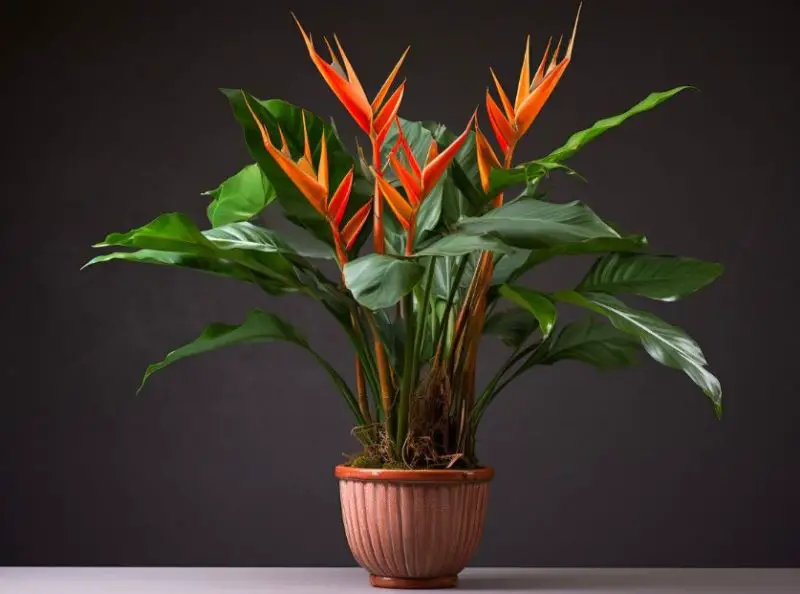The Bird of Paradise plant, known scientifically as Strelitzia reginae and Strelitzia nicolai, is one of the most distinctive and sought-after tropical plants. Named for its exotic flowers that resemble a bird in flight, this plant brings an unparalleled tropical aesthetic to indoor and outdoor spaces alike. While it might appear challenging due to its luxurious appearance, the Bird of Paradise is relatively easy to grow and can thrive with proper care.
In this comprehensive guide, we will take an in-depth look at everything you need to know to care for and grow the Bird of Paradise successfully, including light, water, temperature, fertilization, common problems, and propagation techniques.
Overview of the Bird of Paradise Plant

The Bird of Paradise plant, scientifically known as Strelitzia reginae and Strelitzia nicolai, belongs to the Strelitziaceae family. This herbaceous perennial is renowned for its striking, bird-like flowers. It typically grows to a mature height of 3.5 to 6 feet and a width of 3 to 4 feet. The plant thrives in full to partial sun and prefers loamy, well-draining soil with a slightly acidic pH.
Blooming mainly from late winter to early spring, the flowers come in vibrant shades of orange or white. Native to South Africa, the Bird of Paradise is hardy in USDA zones 10 to 12, but it is toxic to pets.
Bird of Paradise Plant Appearance
This exotic plant grows upright from the soil, with no visible trunk. Its large, banana-like leaves can reach 12 to 18 inches in length. These leaves may develop splits, especially when exposed to wind or when brushed against in high-traffic areas. The flowers themselves are a true spectacle, boasting a striking combination of orange and blue hues or white and blue, depending on the variety.
Native Habitat
The Bird of Paradise originates from South Africa’s subtropical regions, where it thrives in warm, humid conditions. Its tropical roots mean that while it can be grown in outdoor gardens in hardiness zones 10-12, it is often cultivated as a houseplant in colder climates.
Bird of Paradise Plant Care
Light Requirements
Bird of Paradise requires bright light to flourish and produce its iconic flowers. Ideally, the plant should receive a mix of indirect sunlight and some direct exposure, but it must be protected from harsh midday sun, which can scorch the leaves. An east- or west-facing window is perfect for indoor growth, while outdoor plants should be placed in partial shade to avoid damage.
When grown indoors, too little light can cause the plant to become leggy and prevent blooming. Six hours of bright light daily is ideal for flowering, so if your indoor space is low on sunlight, consider supplementing with grow lights.
Soil and Potting
For optimal growth, use a rich, well-draining potting mix or a compost blend. Whether growing indoors or outdoors, drainage is key, as the Bird of Paradise is sensitive to waterlogged soil. Ensure pots have drainage holes, and consider placing a layer of gravel at the bottom of the pot to improve water flow.
Watering Routine
The Bird of Paradise enjoys consistently moist soil, particularly during the growing seasons of spring and summer. Water the plant regularly, allowing water to flow freely through the drainage holes. However, it’s important to strike a balance; overwatering can lead to root rot, while underwatering will cause the leaves to yellow or curl.
During the fall and winter months, reduce the frequency of watering, allowing the soil to dry out slightly between watering sessions.
Temperature and Humidity
Bird of Paradise thrives in warm, humid conditions and is not tolerant of cold temperatures. For indoor plants, maintain an ambient temperature above 60°F (16°C) throughout the winter. This tropical plant enjoys humidity, so misting the plant regularly can help keep it happy in drier indoor climates. If possible, placing a humidifier nearby is beneficial during colder months.
Fertilizing Needs
Bird of Paradise is a heavy feeder, requiring regular fertilization to maintain its vibrant growth and produce flowers. Feed the plant weekly during the growing season with a balanced liquid fertilizer. Alternatively, slow-release pellets applied in early spring can provide continuous nourishment throughout the growing period.
Avoid over-fertilizing, which can lead to an accumulation of salts in the soil, potentially harming the plant.
Placement and Growing Conditions
For indoor growth, the Bird of Paradise should be placed in a well-lit area, ideally in front of an east- or west-facing window. If your home only offers spaces with indirect light, rotating the plant regularly will ensure even growth.
During summer months, consider moving the plant outdoors for better light exposure. However, gradually transition it to avoid shock from the change in light intensity.
Types of Bird of Paradise
While there are five species within the Strelitzia genus, two types are most commonly grown as houseplants:
- Strelitzia reginae (Orange Bird of Paradise): Known for its bright orange and blue flowers.
- Strelitzia nicolai (White Bird of Paradise): Larger in size with white and blue blooms, often referred to as the “giant” Bird of Paradise.
Other less common varieties include:
- Strelitzia reginae ‘Glauca’: Features powdery, gray foliage.
- Strelitzia juncea: Has reed-like stems with few or no leaves.
Pruning and Maintenance
Pruning helps to maintain the aesthetic appeal and health of the Bird of Paradise plant. Remove any dead, damaged, or diseased leaves by cutting them off with sterilized tools. For larger plants, loppers or pruning saws may be necessary. Always aim to cut the leaves and stems down to just above the soil line.
Deadheading Flowers
Bird of Paradise flowers typically last around three weeks. Once they start to wither, remove them to encourage the plant’s energy to be directed towards new growth.
Propagating Bird of Paradise
Division
The most effective way to propagate Bird of Paradise is through division. This method works best with mature plants that have bloomed for at least three years. Follow these steps for successful propagation:
- Remove offshoots at the base with at least three leaves.
- Use a sharp knife, saw, or shovel to divide the rhizome.
- Repot the division in a new container with well-draining soil.
Growing from Seed
Growing Bird of Paradise from seed requires patience, as seeds can take up to two months to germinate. Here’s how to start seeds:
- Soak seeds for 24 to 48 hours and remove any orange filaments.
- Nick the seed coat to enhance germination.
- Plant the seeds 1 inch deep in a well-draining mix and keep the soil moist.
- Place in indirect sunlight and maintain a temperature around 80°F (27°C).
Potting and Repotting
Bird of Paradise plants grow rapidly and need adequate space for their roots. A plant that is 3-4 feet tall should be potted in a 10-inch container, while a 5-6 foot plant requires a 14-inch pot. Repotting is necessary every spring when the plant outgrows its pot, but once the plant matures, it benefits from being slightly pot-bound, which encourages flowering.
Common Problems and Pests
Root Rot
Root rot is a common issue caused by overwatering. The soil becomes waterlogged, leading to fungal infections. To treat root rot, remove the plant from its pot, trim away any rotted roots, and repot in fresh soil.
Pests
Common pests include aphids, scale, and whiteflies. Treat infestations with insecticidal soap or systemic pesticides to prevent the spread.
Leaf Curling or Yellowing
Curling leaves often indicate underwatering, while yellowing leaves could suggest nutrient deficiency or low humidity.
Slits in Leaves
Wind or indoor drafts can cause the leaves to develop slits, which helps with air circulation. These slits are generally harmless but can be minimized by ensuring stable conditions.
Encouraging Blooms
A Bird of Paradise will bloom when it reaches maturity, typically after 4 to 5 years. Ensure the plant receives ample light (at least 6 hours daily) and is slightly pot-bound. Regular feeding during the growing season will also promote flowering.
Conclusion
The Bird of Paradise plant, with its bold leaves and striking flowers, is a showstopper both indoors and outdoors. By understanding its unique needs and providing the right balance of light, water, and nutrients, you can enjoy this tropical beauty for years to come. Whether you’re growing the orange Strelitzia reginae or the white Strelitzia nicolai, this plant is sure to become a focal point in your home or garden.






